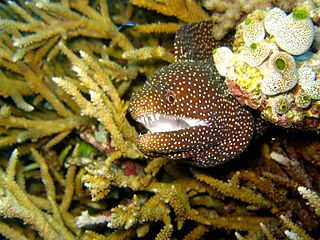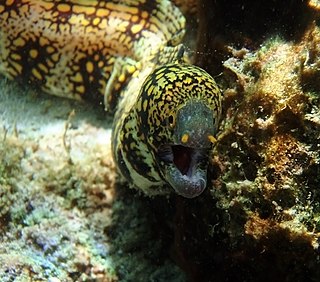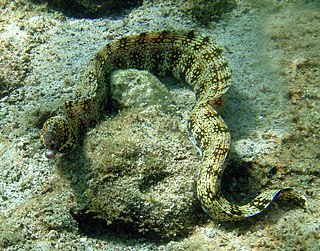
Moray eels, or Muraenidae, are a family of eels whose members are found worldwide. There are approximately 200 species in 15 genera which are almost exclusively marine, but several species are regularly seen in brackish water, and a few are found in fresh water.

Labrisomids are small blennioids (blennies), percomorph marine fish belonging to the family Labrisomidae. Found mostly in the tropical Atlantic and Pacific Ocean, the family contains about 110 species in 15 genera.

Blenny is a common name many types of fish, including several families of percomorph marine, brackish, and some freshwater fish sharing similar morphology and behaviour. Six families are considered "true blennies", grouped under the order Blenniiformes; its members are referred to as blenniiformids. About 151 genera and nearly 900 species have been described within the order. The order was formerly classified as a suborder of the Perciformes but the 5th Edition of Fishes of the World divided the Perciformes into a number of new orders and the Blenniiformes were placed in the percomorph clade Ovalentaria alongside the such taxa as Cichliformes, Mugiliformes and Gobiesociformes.

Gymnothorax is a genus of fish in the family Muraenidae found in Atlantic, Indian and Pacific Ocean. With more than 120 species, it the most speciose genus of moray eels.

Echidna is a genus of moray eels in the family Muraenidae.

Henry Augustus Pilsbry was an American biologist, malacologist and carcinologist, among other areas of study. He was a dominant presence in many fields of invertebrate taxonomy for the better part of a century. For much of his career, his authority with respect to the classification of certain substantial groups of organisms was unchallenged: barnacles, chitons, North American terrestrial mollusks, and others.

The snowflake moray also known as the clouded moray among many various vernacular names, is a species of marine fish of the family Muraenidae.

The giant moray is a species of moray eel and a species of marine fish in the family Muraenidae. In terms of body mass, it is the largest moray eel; however, the slender giant moray is the largest in terms of body length.

Gymnothorax pictus, the painted moray, paintspotted moray or peppered moray, is a moray eel. The Chamorro name of the eel is títugi.

Echidna nocturna is a moray eel found in the eastern Pacific Ocean, in the Gulf of California and around Peru and the Galapagos Islands. It was first named by Cope in 1872, and is commonly known as the freckled moray or the palenose moray. It was discovered that Echidna nocturna and Muraena acutis are the same species.

Cochlespira is a genus of sea snails, marine gastropod mollusks in the family Cochlespiridae.

Dentarene is a genus of sea snails, marine gastropod mollusks in the family Liotiidae.
Gymnothorax polyspondylus is a moray eel found in the eastern central Pacific, around Hawaii. It was first named by Böhlke and Randall in 2000, and is commonly known as the manyvertebrae moray.
Gymnothorax prismodon is a moray eel found in the eastern central Pacific Ocean. It is commonly known as the sawtooth moray.

The roving coral grouper, also known as the spotted coral grouper, is a species of marine ray-finned fish, a grouper from the subfamily Epinephelinae which is part of the family Serranidae, which also includes the anthias and sea basses. It is found in the Indo-Pacific, although the Red Sea taxon, P.. marisrubri, is regarded as a separate species by some authorities.
Apterichtus ansp, the Academy eel, is a species of snake eel native to the western Atlantic Ocean from North Carolina, United States through the Bahamas to Brazil. It is known to dwell down to a maximum depth of 200 metres (660 ft), and leads a benthic lifestyle, inhabiting burrows in the sand in surf areas. This species can reach a length of 54 centimetres (21 in) TL.
The faintsaddled snake eel is an eel in the family Ophichthidae. It was described by John E. McCosker and Eugenia Brandt Böhlke in 1984. It is a marine, temperate water-dwelling eel which is known from the western central Atlantic Ocean. It is known to dwell at a depth of 108 meters.
The dottedline snake eel is a species of eels in the family Ophichthidae. It was described by John E. McCosker and Eugenia Brandt Böhlke in 1984. It is a marine, temperate water-dwelling eel which is known from the western central Atlantic Ocean. It is known to dwell at a depth of 183 meters.

Stomatella lintricula is a species of sea snail, a marine gastropod mollusk in the family Trochidae, the top snails.















